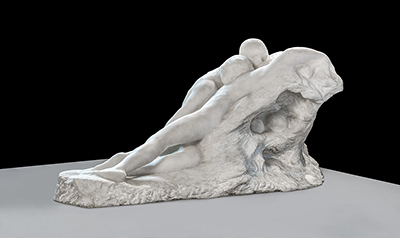Sculpted in 1889, Adonis Awakens is one of Auguste Rodin's most famous works. The subject is a figure from Ovid's Metamorphoses: Adonis, the mortal lover of Venus. According to legend, both Venus and Persephone fell in love with Adonis and fought over him.
Jupiter decreed that they would have to share Adonis: he would return to Persephone for one-third of the year but spend another one-third of the year with Venus. Adonis was allowed to choose who he would spend he remaining third with, electing to spend it with Venus. The story ends in tragedy, with Adonis gored to death by a wild boar. The sculpture shows Adonis sleeping in a hollow tree with Persephone on his chest, while Venus leans over them.
This powerful piece is an excellent example of Rodin's later works, showing his trademark combination of highly detailed and finished elements contrasted with looser, rougher sculpting in other areas. In Adonis Awakens, the contrast between the more detailed areas and the less finished sections is particularly marked, giving the impression that the figures are emerging from the natural stone. This reflects Rodin's striving for perfection through the imperfect, with the rougher elements contributing to the overall perfection of the whole piece. The piece is sculpted from white marble, evoking the classical sculpture of the period when Ovid wrote; the pristine white marble gives the piece an ethereal air.
Adonis Awakens (also known as The Awakening of Adonis or, in the original French, Le Réveil d'Adonis) is part of a series of works based on classical mythology that Rodin created. It is interesting to contrast Adonis Awakens with a later related work, The Death of Adonis. In this sculpture Adonis is shown as having been killed, with the grieving Venus attending his corpse. The more sensual pose of Venus in Adonis Awakens is in strong contrast to the tension shown in the body of Venus in the later sculpture. Both works draw upon the many studies that Rodin produced, showing the figures singly as well as together.




